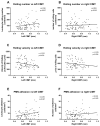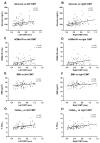Association between Proinflammatory Markers, Leukocyte-Endothelium Interactions, and Carotid Intima-Media Thickness in Type 2 Diabetes: Role of Glycemic Control
- PMID: 32764458
- PMCID: PMC7465892
- DOI: 10.3390/jcm9082522
Association between Proinflammatory Markers, Leukocyte-Endothelium Interactions, and Carotid Intima-Media Thickness in Type 2 Diabetes: Role of Glycemic Control
Abstract
Glycated hemoglobin monitorization could be a tool for maintaining type 2 diabetes (T2D) under control and delaying the appearance of cardiovascular events. This cross-sectional study was designed to assess the role of glycemic control in modulating early-stage markers of cardiovascular complications. One hundred and eight healthy controls and 161 type 2 diabetic patients were recruited and distributed according to their glycemic control, setting the threshold at 6.5% (good control). Biochemical and anthropometrical parameters were registered during the initial visit, and peripheral blood was extracted to obtain polymorphonuclear cells and analyze inflammatory markers, adhesion molecules, leukocyte-endothelium interactions, and carotid intima-media thickness. Correlations between these parameters were explored. We found that inflammatory markers and adhesion molecules were augmented in type 2 diabetic subjects with poor glycemic control. Polymorphonuclear leukocytes interacted more with the endothelium in the diabetic population, and even more significantly in the poorly controlled subjects. In parallel, carotid intima-media thickness was also increased in the diabetic population, and the difference was greater among poorly controlled subjects. Finally, correlation measurement revealed that carotid intima-media thickness was related to glycemic control and lipid metabolism in diabetic patients. Our results suggest that glycemic control delays the onset of cardiovascular comorbidities in diabetic subjects.
Keywords: carotid intima–media thickness; endothelial function; glycated hemoglobin; inflammation; type 2 diabetes.
Conflict of interest statement
The authors declare no conflict of interest.
Figures






References
-
- Zhang Y.-B., Pan X.-F., Chen J., Xia L., Cao A., Zhang Y., Wang J., Li H., Yang K., Guo K., et al. Combined lifestyle factors and risk of incident type 2 diabetes and prognosis among individuals with type 2 diabetes: A systematic review and meta-analysis of prospective cohort studies. Diabetologia. 2020;63:21–33. doi: 10.1007/s00125-019-04985-9. - DOI - PubMed
Grants and funding
- PI19/00838, PI19/0437,CIBERehd CB06/04/0071 ,FI17/00126 and FI17/00144/Instituto de Salud Carlos III
- UGP-15-220/Foundation for the Promotion of Health and Biomedical Research in the Valencian Region (FISABIO)
- PROMETEO/2019/027/Conselleria de Sanitat Universal i Salut Pública
- GRISOLIAP/2019/091/Generalitat Valenciana
- CES/10/030, CPII16/00037/conselleria de Sanitat Universal i Salut Publica/ Instituto de Salud Carlos III
LinkOut - more resources
Full Text Sources

